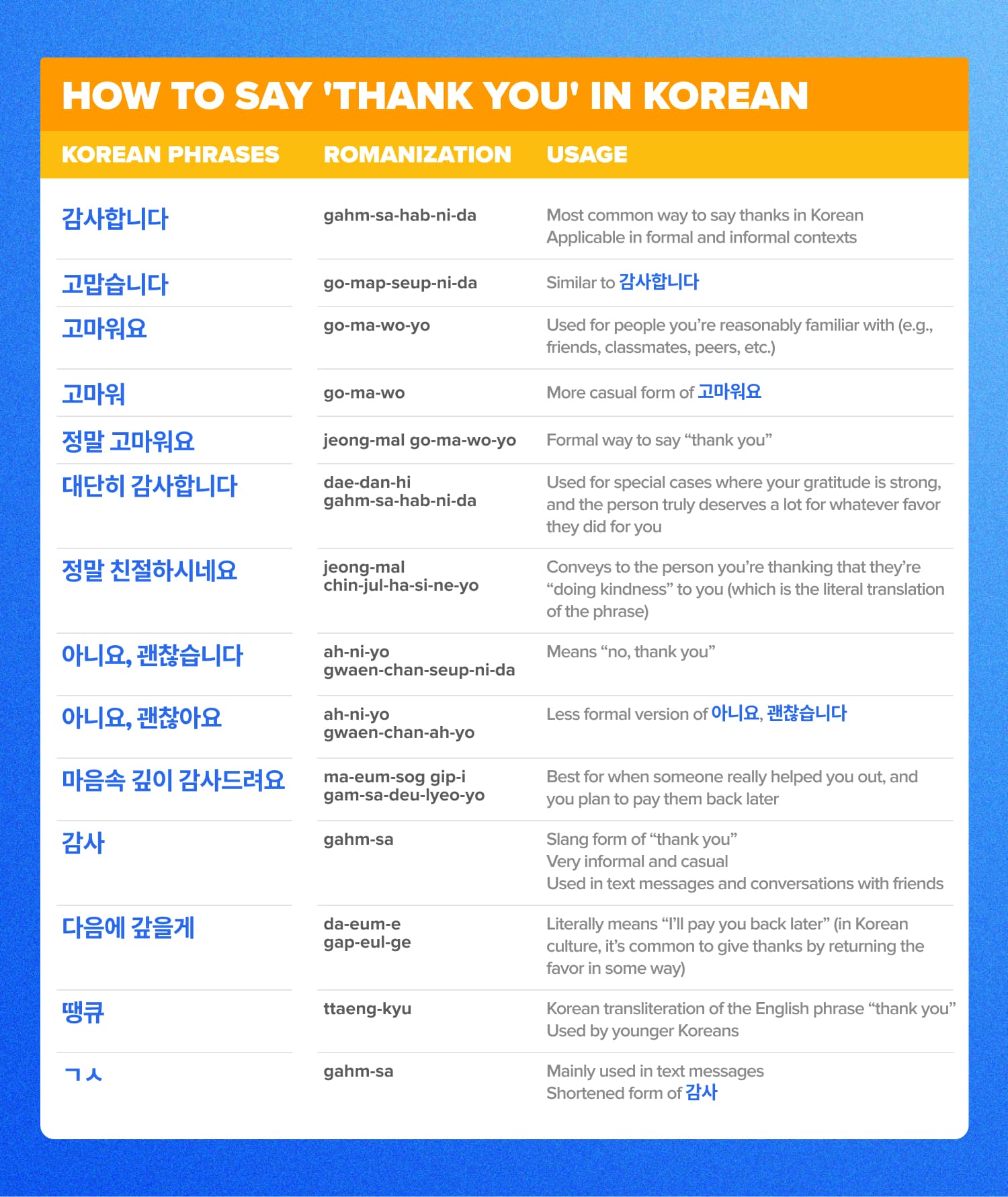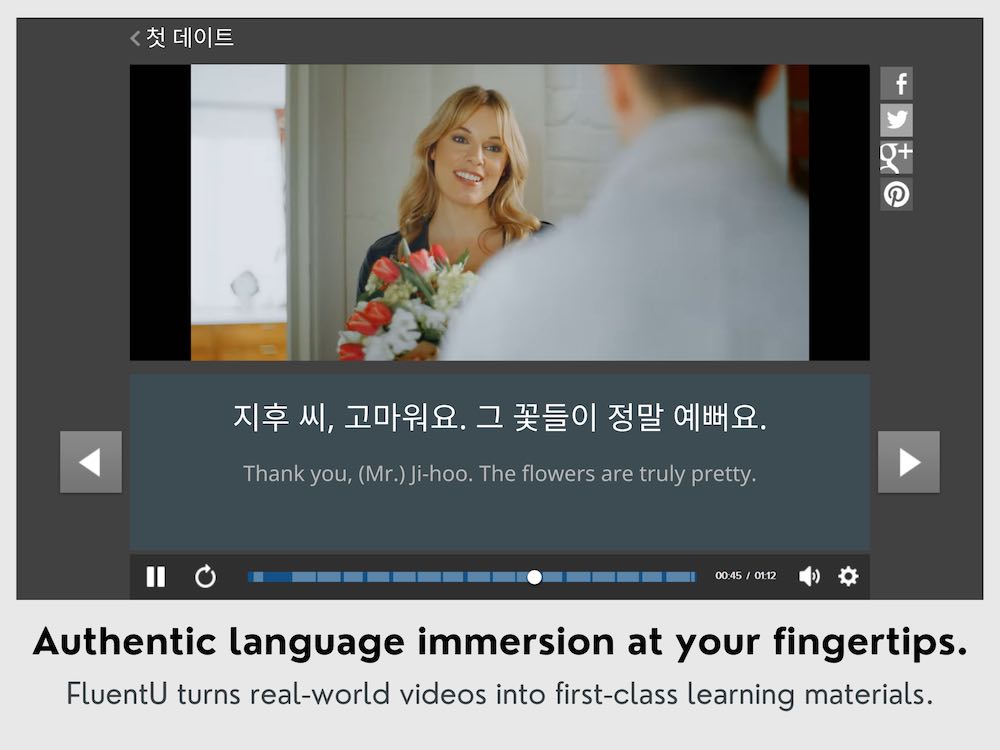
14 Ways to Say Thank You in Korean
The most popular and well-known way to say thank you in Korean is 감사합니다 , but there are plenty of other expressions you can use to convey gratitude according to formality.
For example, you wouldn’t necessarily thank your boss the same way you’d thank a close friend—and vice versa!
In this post, you’ll find out exactly how and when to use “thank you” in Korean across different contexts.
If you prefer a video lesson, you can watch here (though we’ll cover some additional phrases in the written lesson below):
Contents
- How Formality Affects the Way You Say “Thank You” in Korean
- The Most Popular Ways to Say Thank You in Korean
- Formal Ways to Say Thank You in Korean
- Polite Ways to Say “Thank You” in Korean
- Informal Ways to Say Thank You in Korean
- How to Say Thank You in Korean Slang
- How to Respond to “Thank You” in Korean
- And One More Thing...
Download: This blog post is available as a convenient and portable PDF that you can take anywhere. Click here to get a copy. (Download)
How Formality Affects the Way You Say “Thank You” in Korean
In English, giving thanks is quite straightforward. “Thank you” is appropriate for most contexts, while “thanks” can be a bit more casual.
It’s a little different in Korean. As you know, respect and etiquette is kind of a big deal in Korean culture, and the social rules trickle down to how you speak.
In the Korean language, there are different registers—i.e., how you speak depends on the context in which you’re speaking or to whom you’re speaking. Expressing this register is done in different ways, from assigning honorific titles to changing up the grammatical structure of your sentences.
The age difference between you and the person you’re talking to can also affect how you say thank you. Like most East Asian cultures, Korean culture incorporates Confucian principles that place a special significance on elders. Following these principles, you generally address elders using formal speech, while informal or casual speech is more appropriate for peers and younger people.
Keep in mind that your age in Korea may not necessarily be the same as your age according to the Western calendar. In other words, someone may actually be older than you think!
Now that you have a bit of background on registers in Korean speech, we can now get into the different ways to say “thank you” in Korean according to formality.
The Most Popular Ways to Say Thank You in Korean
감사합니다 (gahm-sa-hab-ni-da)
English: Thank you
감사합니다 is the most common way to say thanks in Korean. It’s the safest go-to expression of gratitude, especially in situations where you’re not sure exactly what you’re supposed to say. You can use this for strangers or seniors in terms of age or rank, like your boss, supervisor, etc.
Let’s break down the phrase a little further:
- 감사 is the part that means “thanks” or “gratitude.”
- 합니다 combines the verb phrase 하다 (to do) and the formal polite ending – ㅂ니다 (b-ni-da) to emphasize that you’re showing respect.
Together, these words literally translate to “I am doing thanks to someone.”
You can add what you’re giving thanks to before this phrase:
선물을 주셔서 감사합니다.
(sun-mul-eul ju-syeo-seo gahm-sa-hab-ni-da)
Thank you for the gift.
고맙습니다 (go-map-seup-ni-da)
English: Thank you
고맙다 (go-map-da) is a Korean native word that means “to be thankful.” By adding the formal polite ending – 습니다 (seup-ni-da), this phrase becomes relatively formal and polite.
That said, it’s also generally safe to use in less serious or casual contexts, such as in a store, with people you know or people who are around the same age as you.
If you’re not sure when to use this one, don’t worry! You can always fall back on 감사합니다, since there’s really no strong difference between that and 고맙습니다 in daily, non-business contexts.
와 주셔서 고맙습니다.
(wa ju-syeo-seo go-map-seub-ni-da)
Thank you for coming.
고마워요 (go-ma-wo-yo)
English: Thank you
Notice the lack of the formal -습니다 here.
Use this for those you’re reasonably familiar with, like a friend, classmate or those who are closer to you in age.
초대해 줘서 고마워요.
(cho-dae-hae jwo-seo go-ma-wo-yo)
Thank you for the invitation.
고마워 (go-ma-wo)
English: Thank you
Like the last item on our list, this lacks the formal -습니다. That also means you reserve this for friends, siblings, peers, younger people and those who are your junior in terms of rank/social standing.
By removing 요 from 고마워요, you get your first truly casual way to say thanks!
함께 와 줘서 고마워.
(ham-kke wa-jwo-seo go-ma-wo)
Thank you for coming with me.
Formal Ways to Say Thank You in Korean
정말 고마워요 (jeong-mal go-ma-wo-yo)
English: Thank you sincerely
This phrase emphasizes the 고마워요.
정말 can translate to “truly” or “sincerely.” You can tack it on to the more formal phrases we mentioned earlier for a little oomph.
이 선물 정말 고마워요.
(i seon-mul jeong-mal go-ma-wo-yo)
Thank you very much for this present.
대단히 감사합니다 (dae-dan-hi gahm-sa-hab-ni-da)
English: Thank you very much
This is for special cases where your gratitude is strong, and the person truly deserves a lot for whatever favor they did for you.
대단히 means “very much” or “greatly.” This phrase uses the formal 감사합니다, making this quite a respectful and weighty thanks.
항상 생각해 주셔서 대단히 감사합니다.
(hang-sang saeng-gag-hae ju-syeo-seo dae-dan-hi gahm-sa-hab-ni-da)
Thank you for always thinking about me.
정말 친절하시네요 (jeong-mal chin-jul-ha-si-ne-yo)
English: That’s truly kind of you
Again, notice the presence of 정말 to emphasize the sincerity of this phrase.
친절 means kindness, while 하시네요 is a conjugation of the verb phrase “to do.” Together, the two convey to the person you’re thanking that they’re “doing kindness” to you.
먼저 하세요! 정말 친절하시네요.
(meon-jeo ha-syeo-yo! jeong-mal chin-jul-ha-si-ne-yo)
You can do it first! That’s truly kind of you.
아니요, 괜찮습니다 (ah-ni-yo gwaen-chan-seup-ni-da)
English: No, thank you
아니요 is a negatory response, while 괜찮습니다 literally translates to “it’s okay.” So, this ends up coming out as “no, thank you.”
습니다 is once again present to make the phrase more formal.
아니요, 괜찮습니다. 먼저 타세요.
(ah-ni-yo, gwaen-chan-seup-ni-da. meon-jeo ta-se-yo)
No, thank you. Go in first.
Polite Ways to Say “Thank You” in Korean
아니요, 괜찮아요 (ah-ni-yo gwaen-chan-ah-yo)
English: No, thank you / No, it’s okay
This is a less formal version of 아니요, 괜찮습니다. You’re probably picking up on the pattern that occurs when 습니다 is switched with a 아요.
먼저 하시겠습니까?
(meon-jeo ha-si-get-sseub-ni-kka)
Were you here first?
아니요, 괜찮아요.
(ah-ni-yo, gwaen-chan-ah-yo)
No, it’s okay.
2. 마음속 깊이 감사드려요 (ma-eum-sog gip-i gam-sa-deu-lyeo-yo)
English: I keep it deep within my heart / I’m deeply grateful
This is a very courteous way of saying that someone’s kind deed would be remembered for quite a while.
You may want to save it for important moments where someone really helped you out, and you plan to pay them back later.
항상 친절하게 대해 주신 것 마음속 깊이 감사드려요.
(hang-sang chin-jeol-ha-ge dae-hae ju-sin geos ma-eum-sog gip-i gam-sa-deu-lyeo-yo)
I’m deeply grateful that you are always being kind to me.
Informal Ways to Say Thank You in Korean
감사 (gahm-sa)
English: Thanks
This is essentially the slang form of saying thanks. Similar to those in other languages, Korean slang often pares down common phrases to their essentials to get a point across quickly and efficiently.
감사 is very informal and casual, and is something you’ll see in text messages or hear in conversations with friends.
빵 사 줘서 감사.
(ppang sa-jwo-seo gahm-sa)
Thanks for buying the bread.
다음에 갚을게 (da-eum-e gap-eul-ge)
English: I’ll pay you back later
For close friends, it’s sometimes better to promise that you’ll return the favor rather than just simply saying “thank you.” If this is the phrase you plan to use, make sure you actually keep your word!
In Korean culture, it’s typical for “paybacks” to come in the form of money, small gifts, meal purchases or even physical chores. Don’t be surprised if they’re more excessive than expected!
오늘 저녁 사 준 것 다음에 갚을게.
(o-neul jeo-nyeog-sa-jun-geot da-eum-e gap-eul-ge)
I’ll pay you back for the dinner you bought today.
How to Say Thank You in Korean Slang
땡큐 (ttaeng-kyu)
English: Thank you
This is a Korean transliteration of the English “thank you.” Like many Konglish words (Korean words with English origins), it sounds a good deal cuter!
Young Koreans are the ones who typically use Konglish, so they’re more likely to use 땡큐. On the other hand, you don’t want to use this with older Korean folks. Not only is it very casual (and might therefore be considered disrespectful), but there’s also a possibility they just won’t understand you.
배달해 줘서 땡큐.
(bae-dal-hae jwo-seo ttaeng-kyu)
Thank you for the delivery.
ㄱㅅ (gahm-sa)
English: Thanks
If 감사 wasn’t short enough for you, or you’re feeling particularly lazy, then you can just type the first characters for both syllables to get the same message across. In this case, you can shorten 감사 to ㄱㅅ.
It’s very common in Korean text slang to use isolated characters in place of common phrases. For starters, it makes typing much easier for native speakers.
On the other hand, if you’re a learner, do keep in mind that these abbreviations require contextual knowledge. Otherwise, they might just look like typos.
오늘 하루도 ㄱㅅ.
(o-neul ha-lu-do gahm-sa)
Thanks for today.
How to Respond to “Thank You” in Korean
Of course, the most appropriate and expected response to “thank you” is “you’re welcome.” We’ve got you covered in this post:
9 Ways to Say You’re Welcome in Korean | FluentU Korean Blog
You may already know the nuances of expressing gratitude in Korean, but do you know how to say “you’re welcome” in Korean when someone says “thank you”? Whether you’re…
And, by the way, one of the best ways to learn all the thank you and you’re welcome phrases is to watch how they’re used by native speakers in authentic contexts. You can do this on the language learning platform FluentU.
FluentU takes authentic videos—like music videos, movie trailers, news and inspiring talks—and turns them into personalized language learning lessons. You can try FluentU for free for 2 weeks. Check out the website or download the iOS app or Android app. P.S. Click here to take advantage of our current sale! (Expires at the end of this month.)
One of the simplest ways to impress native Korean speakers is to express your gratitude in their language. Not only does it showcase your knowledge of the language, but it also demonstrates a sincere effort to be courteous toward them.
Without further ado, thanks for reading, or as you would say in Korean, 읽어 주셔서 감사합니다 (ilg-uh-ju-syuh-suh gahm-sa-hab-ni-da)!
Download: This blog post is available as a convenient and portable PDF that you can take anywhere. Click here to get a copy. (Download)
If you enjoyed this post, you're already halfway to having the time of your life learning Korean with FluentU!
FluentU makes it possible to learn with K-pop videos, funny commercials, entertaining web series and more. Just a quick look will give you an idea of the variety of FluentU videos on offer:
FluentU really takes the grunt work out of learning languages, leaving you with nothing but engaging, effective and efficient learning. It's already hand-picked the best videos for you (which are organized by level and topic), so all you have to do is simply choose any video that strikes your fancy to get started.
Each word in the interactive captions comes with a definition, audio, image, example sentences and more.
Access a complete interactive transcript of every video under the Dialogue tab, and easily review words and phrases from the video under Vocab.
You can use FluentU’s unique Quiz Mode to learn the vocabulary and phrases from the video through fun questions.
FluentU keeps track of what you're learning, and tells you exactly when it's time for review, giving you a 100% personalized experience.
Review sessions use video context to help embed the words in your memory.
Start using the FluentU website on your computer or tablet or, better yet, download the FluentU app from the iTunes or Google Play store. Click here to take advantage of our current sale! (Expires at the end of this month.)
And One More Thing...








